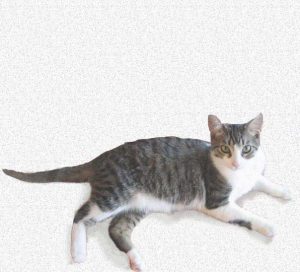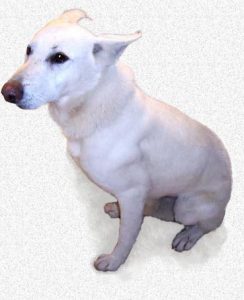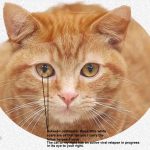Why Is My Dog Or Cat Sneezing?
Sneezing And Upper Respiratory Tract Problems In Dogs And Cats
Ron Hines DVM PhD
You Might Also Find These Other Articles Helpful!

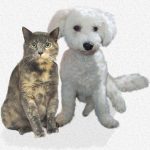

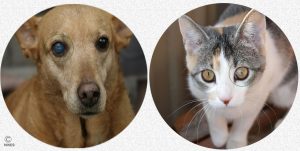
Pets and people usually sneeze for one of two reasons: Either the membranes that line their nose are inflamed or a foreign material of some sort is present in their nostrils.
Nasal membranes become inflamed if your pet was exposed to an irritant or when it has contracted an upper respiratory tract infection.
When young dogs sneeze, it is usually due to an upper respiratory tract infection. When young cats sneeze, several common upper respiratory tract pathogens are often involved. When middle-aged cats sneeze, it is usually due to the Herpes 1 virus of cats. When older pets develop sneezing problems, the causes are more varied. When older pets also experience drainage from only one nostril, nasal polyps and intranasal tumors are often the cause.
Infectious Rhinitis or Sneezing
Most of the sneezing dog that veterinarians examine have contracted an upper respiratory tract infections. Often, the only symptom of these mild infections is the sneezing. Pets commonly get exposed to these organisms at grooming salons, doggy parks and kennels. In people, we would call it a cold, and it moves from person to person in the same way. Dogs and cats invariably sniff new objects so the chances of them becoming infected are far greater. These pet “colds” are caused by airborne virus and bacteria. The virus that cause them do not jump from dogs to cats or vice-versa, but the bacteria involved do.
One particular virus of cats that is often the root cause of sneezing is the feline herpes 1 virus (FHV1, rhinotracheitis). You can read more about that virus here.
The two common “cold”/kennel cough viruses of dogs are the canine parainfluenza virus and the Type-2 Adenovirus. Both can cause sneezing, not just kennel cough signs. Both are highly infectious and are both passed by sneezes and coughs from other sick dogs but also from dogs that are silently carrying the infection. It is very common for the owners of sneezing pets to tell me that their pet was boarded, groomed or exposed to neighboring pets or a doggy park within the past two week or so. Indoor dog shows are another important source of this virus. Pets that were recently obtained from animal shelters are also more likely to develop these problems. You can have your dog vaccinated against kennel cough and most dog owners do. But these vaccines only reduce the severity of your pet’s symptoms – they usually do not prevent infection. (read here)
Very young and very old pets are more at risk. This is because the immune system of young animals is not fully developed. Once the transient immunity that was passed on to these youngsters from their mother subsides, they are susceptible to these organisms until they develop immunity of their own. Older pets may have age-related changes of the nasal membranes that make infections worse and their immune systems may not be as vigorous as they once were. These chronic changes are more common in smushed-faced dogs and cats whose nasal passages are narrower than ordinary dogs and cats. Dogs with this head conformation are also more likely to take longer to recover than dogs with a natural nose conformation.
Bacteria and mycoplasma alone can cause sneezing. Both cats and dogs are susceptible to bacterial upper respiratory tract infections caused by Pasteurella, Bordetella, Streptococci, Chlamydia, mycoplasma and pseudomonad bacteria. Alone or combined with the Adeno-2 virus, they are the causes of kennel cough. Many of these respiratory bacteria are not particular about whose nose or eyes they irritate and have been known to cause similar problems in humans.
Some recovered pets silently carry these bacteria and virus in their system. Although these pets appear perfectly healthy, they can spread the infections to any animals that they come in contact with.
Next to the herpes 1 virus, Calicivirus, Chlamydia and mycoplasma are the most common cause of sneezing cats. Although sneezing may be the only sign of infection, most cats also have conjunctivitis (inflamed eye membranes) and some even run a low-grade fever and feel under the weather. Again, many healthy pets harbor these viruses and bacteria and spread them. (When sneezing begins In a household of pets, it is quite rare for more than one or two to show any signs; although all were exposed.)
The herpes1/rhinotracheitis virus is the cause of over two-thirds of the sneezing cats most veterinarians see in their practices. The incubation period after exposure to this virus is about 2-6 days. Relapses are common and cats that harbor this virus are usually infected for life. Only a few of them, however, ever show signs of this virus again. But much like the cold sore virus of humans, stress of any sort will cause a few cats to resume shedding the virus and show nasal signs, ocular (eye) signs or both. It is the bane (annoyance) of catteries and animal shelters alike. Sneezing usually subsides 5-10 days after it begins.
A recent article in the AVMA Journal compared the effectiveness of several antibiotics in combating this problem in shelter cats. Daily amoxicillin-clavulanic acid (Augmentin®) or Doxycycline were more effective than a 14-day cefovecin (Convenia®) injection. (read here)
What About Cats?
The most common cause of sneezing in cats is the Herpes1/rhinotracheitis virus. Long-term immunity to this virus is poor as it is with all herpes viruses. It is very common in the cat population and very few cats have never been exposed to it. The majority of cats show little or no symptoms – perhaps a mild transient conjunctivitis and sneezing. But some cats relapse whenever they are under stress. Much like herpes lip ulcers in us humans. Dogs also have their own distinct herpes virus. However, the dog variety of this virus rarely causes noticeable symptoms in adult dogs. When it is a problem in dogs, it is because it results in lost pregnancies.
What Are Some Noninfectious Causes of Sneezing?
Household irritants
The same household products that cause you to sneeze can cause your pet to sneeze. The most common culprit for cats is dusty cat litter containing small spicules (sharp crystals) of silica. Perfumes, cigarette smoke, household cleaners, fiberglass, bug spray and deodorants are only a few of the products that can cause your pet to sneeze.
Allergies
Although most pet allergies cause itching or wheezing, some pets sneeze due to pollens and mold in the air. If the problem occurs only seasonally, antihistamines might be of help. However, inhalant allergies in dogs and cats are much more likely to cause generalized itching and food allergies, when they occur, generally cause diarrhea.
Foreign Bodies
It is not uncommon for pets to poke their nose into grassy or dusty areas and come away with a small portion of grass or seedpods lodges in their nostril. Any nasal drainage of this sort will be confined to the side that has the object. Most pets eventually sneeze these objects out but some of them must be physically removed. These lodged objects will also cause drainage from the affected side of their nose.
When this occurs in older dogs and cat, the cause is usually different. These older pets are subject to nasal polyps, tumors and degenerative changes in their airways. As with foreign objects, the problem is usually confined to one nostril.
Tooth Abscesses
In both dogs and cats the third upper premolar tooth has roots that penetrate close to the nasal passages. If this tooth, or the ones adjacent to it, becomes infected, sneezing and nasal drainage may occur. You can read more about that problem here.
Breed Characteristics
Certain breeds of dogs and cats have compressed nasal passages due to the shape of their head. These are called brachycephalic breeds. Persian cats and other cats with a flat face are more likely to sneeze due to infection or irritating products and to sneeze longer. Any of the dogs breed that snore (Pekingese, pugs, bulldogs, Lhasa Apsos, Shia Tzu etc.) share this problem.
What Treatments Might Help?
Veterinarians try to prevent upper respiratory tract infections in dogs and cats by vaccinating against the organisms that are commonly involved. However, most cats have already acquired the herpes 1 virus before their first kitten-hood vaccination and vaccine immunity to most upper-respiratory pathogens in dogs and cats is short-lived. So keeping your pets isolated from infected and carrier animals or places where they frequent is a much better approach. That goes for crowded veterinary waiting rooms and vaccination clinics as well.
There is an old joke among veterinarians that sneezing left untreated lasts about 2 weeks; but when properly treated it passes in 14 days. This has a basis in fact and sneezing pets rarely warrant antibiotics. But it is not always so – sometimes sneezing is only the first sign of a more serious respiratory tract infection. This is particularly so when your pet’s activity level and appetite are diminished. One helpful way to tell if the problem is minor or more major is to take your pet’s temperature with a rectal thermometer. (Don’t bother to see if its nose is warm or cold – that never works) If the pet’s temperature or its appetite, respiratory rate or activity level has changed significantly, just bring the pet in to your vet to be examined.
The normal temperature of a cats and dogs is about 101.5 – 102.5 F (38.6-39 C) If the pet’s temperature is over 102.7 it might indicate that the problem will develop into a more serious respiratory tract infection. In that case, antibiotics and other treatment could shorten its period of illness. Otherwise, rest, a comfortable environment and good nutrition will probably be sufficient. Feed your pets savory and strong aroma foods during periods of nasal congestion because their appetite depends on their ability to smell of food and that ability may be diminished.
If its nostrils become raw and inflamed, a bland ophthalmic ointment and frequent cleaning of the nose with warm, wet pledgets of cotton might be all that is required.
As I mentioned earlier, when Herpes1/Rhinotracheitis/cat flu virus is the cause of the sneezing in cats, it is difficult to permanently cure them. When this disease attacks cats repeatedly when it re-emerges from the pet’s nervous system where it lays dormant. It sometimes causes irreversible erosions and changes in linings of the nasal passages (nasoturbinate bones) that can be helped but never entirely cured. As I mentioned, this virus persists in cats throughout their lifetime – but usually in a dormant form similar to shingles in humans. Low stress, good nutrition, vitamin A and antibiotics to combat secondary bacterial infections usually cause the disease to go back into remission.
If that treatment does not cure the cat’s sneezing in a few weeks, Medications like trifluridine (Viroptic®) or idoxuridine ophthalmic drops administered in their nose up to four times a day sometimes will. Steam administration, nebulization, or taking the pet with you into a hot shower area (don’t get it wet) will helps cleanse its nose of exudates and open its nasal passages. Some veterinarians give acyclovir, but I have not found it much help.
The amino acid, l-lysine, seems to help many cases of herpes1/rhinotracheitis resolve. This amino acid is thought to reduce the amount of another amino acid, arginine, that is present in the cat’s body. Arginine is thought to be necessary for herpes virus to reproduce. The suggested lysine dose is 250-500 mg per day sprinkled on canned cat food. Some give this supplement until the acute flare-up has resolved. But many cat owners continue the supplement indefinitely. Lysine can be purchased at health food stores. Pick a brand that is propylene glycol-free.
Sometimes, nasal corticosteroid spray (such as Nasocort® that contains triamcinolone) are helpful to dogs and cats with chronic nasal problems that lead to sneezing (chronic rhinitis). Be cautious when using these over the counter products without the council of your veterinarian. Placing a few drops of an ophthalmic or nasal saline rinse into the pet’s nostrils three times a day might also help if your pet will put up with that. Some owners find antihistamines like North American-formulated Benadryl® (diphenhydramine) help. Remember to only give pets doses that are appropriate for their weight. Also, the UK/European Benadryl® formula is not the same as the one sold in America. I am only acquainted with the North American formula. (read here)
Foreign bodies that have lodged in the nose require different treatment. With time, the drainage from such objects becomes thick and yellow-greenish in color. The drainage is sometimes pinkish with blood.
It is very difficult for veterinarians to see into the nasal passages of small dogs and cats. X-rays often do not visualize small objects or tumors – CAT scans and MRIs are somewhat better. An instrument called a nasal endoscope will sometimes allow veterinarians to look into the pet’s nasal passages – but it is most successful in larger animals. When one is lucky, objects can be grasped with an alligator forceps and remove or tissue biopsies can be removed for study. More commonly veterinarians dispense antibiotic drops and nasal saline drops to the affected nostril and hope the pet will sneeze any foreign object out with time. When that isn’t successful, the object can sometimes be flushed out with a catheter under anesthesia. When the problem turns out to be a tumor, surgery is complicated, disfiguring and rarely curative. These pets do have a chemotherapy/radiation option.
I am always most concern when I encounter one-sided drainage in older dogs and cats that persists beyond a week or two. Most do turn out to have a tumor growing within the nasal passages and most of these tumors are malignant. They are often adenocarcinomas. But because of their location, it is very difficult to obtain a portion of these masses for pathological examination.
Are There New Options To Determine The Infectious Causes Of Sneezing and URIs?
Yes,
Within the last few years, veterinarians have been given a tremendous tool for sorting out the various bacteria and virus that cause chronic sneezing in pets. These are the Real-Time Polymerase Chain Reaction Tests (RT-PCR) that identify minute amounts of pathogen genetic material without having to grow the organisms in the laboratory. One of my favorite is the Taqman lab at UC Davis. They use RT-PCR to look for six of the most common causes of upper respiratory, nasal and/or chronic eye problems in cats (e.g. bordetella, chlamydia, calicivirus, herpes 1,influenza and mycoplasma). Similar panels are available for dogs. If your kitty has persistent sneezing, some of these organisms are not the likely cause; but the panels often test for all of them. The test’s limitation is that the most common cause of sneezing, the Herpes-1 virus, is so stealthy that it can avoid detection with the PCR test when the cat is not experiencing a virus flare-up. So if the PCR test is positive for herpes-1, your cat is definitely a carrier of this virus. But if it is negative, the virus might still be sleeping somewhere deep in the cat’s nerve cells. It is best run during a flare-up.
You are on the Vetspace animal health website
Visiting the products that you see displayed on this website help pay the cost of keeping these articles on the Internet.

